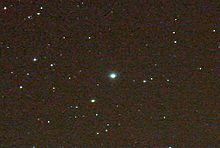19 Aquilae
Apparence
19 Aquilae
Image capturée depuis le Mount Laguna, en Californie.
| Ascension droite | 19h 08m 59,90684s[1] |
|---|---|
| Déclinaison | +06° 04′ 23,4857″[1] |
| Constellation | Aigle |
| Magnitude apparente | 5,227[2] |
Localisation dans la constellation : Aigle | |
| Type spectral | F0 III-IV[3] |
|---|---|
| Magnitude apparente (U) | 5,59[4] |
| Magnitude apparente (B) | 5,57[5] |
| Indice U-B | +0,020[2] |
| Indice B-V | +0,345[2] |
| Variabilité | Gamma Doradus[6] |
| Vitesse radiale | −46,7 km/s[7] |
|---|---|
| Mouvement propre |
μα = −5,485 mas/a[1] μδ = −73,785 mas/a[1] |
| Parallaxe | 22,956 3 mas[1] |
| Distance | ∼ 142 a.l. (∼ 43,5 pc) |
| Magnitude absolue | 1,94[8] |
| Masse | 1,59 M☉[9] |
|---|---|
| Rayon | 2,50 R☉[1] |
| Gravité de surface (log g) | 4,13[3] |
| Luminosité | 12,8 L☉[1] |
| Température | 6 784 K[9] |
| Métallicité | +0,03[3] |
| Rotation | 57 km/s[10] |
| Âge | 2,25 milliards d' a[9] |
Désignations
19 Aquilae (en abrégé 19 Aql) est une étoile de la constellation de l'Aigle, située à ∼ 142 a.l. (∼ 43,5 pc) de la Terre.
Références
[modifier | modifier le code]- (en) Cet article est partiellement ou en totalité issu de l’article de Wikipédia en anglais intitulé « 19 Aquilae » (voir la liste des auteurs).
- (en) A. G. A. Brown et al. (Gaia collaboration), « Gaia Data Release 2 : Summary of the contents and survey properties », Astronomy & Astrophysics, vol. 616, , article no A1 (DOI 10.1051/0004-6361/201833051, Bibcode 2018A&A...616A...1G, arXiv 1804.09365). Notice Gaia DR2 pour cette source sur VizieR.
- (en) T. Oja, « UBV photometry of stars whose positions are accurately known. III », Astronomy & Astrophysics Supplement Series, vol. 65, no 2, , p. 405–4 (Bibcode 1986A&AS...65..405O).
- (en) Suchitra Balachandran, « Lithium depletion and rotation in main-sequence stars », The Astrophysical Journal, Part 1, vol. 354, , p. 310–332 (DOI 10.1086/168691, Bibcode 1990ApJ...354..310B).
- (en) T. Oja, « UBV photometry of stars whose positions are accurately known », Astronomy & Astrophysics Supplement Series, vol. 57, , p. 357 (Bibcode 1984A&AS...57..357O).
- (en) T. Oja, « UBV photometry of stars whose positions are accurately known. VII », Astronomy & Astrophysics Supplement Series, vol. 100, no 3, , p. 591–592 (ISSN 0365-0138, Bibcode 1993A&AS..100..591O).
- (en) E. Poretti et al., « Preparing the COROT space mission: Incidence and characterisation of pulsation in the lower instability strip », Astronomy & Astrophysics, vol. 406, , p. 203–211 (DOI 10.1051/0004-6361:20030711, Bibcode 2003A&A...406..203P, arXiv astro-ph/0304422).
- (en) R. Wielen et al., « Sixth Catalogue of Fundamental Stars (FK6). Part I. Basic fundamental stars with direct solutions », Veröffentlichungen Astronomisches Rechen-Institut Heidelberg, Astronomisches Rechen-Institut Heidelberg, vol. 35, , p. 1 (Bibcode 1999VeARI..35....1W).
- (en) J. Holmberg, B. Nordström et J. Andersen, « The Geneva-Copenhagen survey of the solar neighbourhood. III. Improved distances, ages, and kinematics », Astronomy & Astrophysics, vol. 501, no 3, , p. 941–947 (DOI 10.1051/0004-6361/200811191, Bibcode 2009A&A...501..941H, arXiv 0811.3982).
- (en) R. Earle Luck, « Abundances in the Local Region. I. G and K Giants », The Astronomical Journal, vol. 150, no 3, , p. 88 (DOI 10.1088/0004-6256/150/3/88, Bibcode 2015AJ....150...88L, arXiv 1507.01466).
- (en) C. Schröder, Ansgar Reiners et Jürgen H. M. M. Schmitt, « Ca II HK emission in rapidly rotating stars. Evidence for an onset of the solar-type dynamo », Astronomy & Astrophysics, vol. 493, no 3, , p. 1099–1107 (DOI 10.1051/0004-6361:200810377
 , Bibcode 2009A&A...493.1099S).
, Bibcode 2009A&A...493.1099S).


